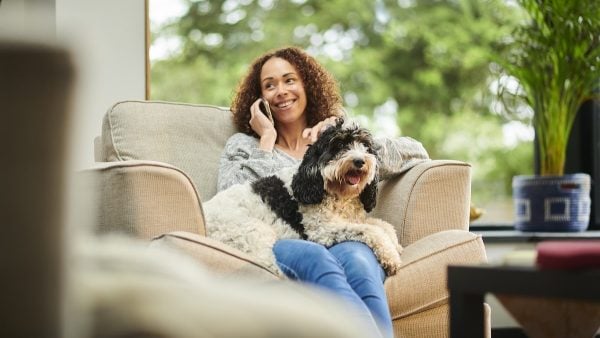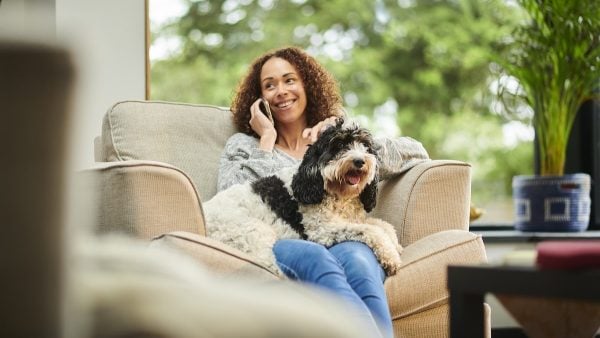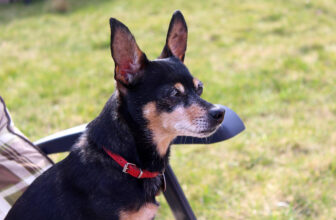
Check out our latest products
- Not a substitute for professional veterinary help.
Like any loving pet parent, you might feel a little nervous about boarding your dog or hiring a sitter for the first time. Try not to worry, though! A little preparation can help you and your dog feel safe and comfortable until you’re back together.
Preparing for your trip starts with considering your options early. This helps make sure your boarding facility or sitter of choice has availability—and it’s always wise to line up a backup, just in case.
Find out everything you need to set your dog up for success—and get some peace of mind yourself—with these 10 tips for boarding your dog.
1. Write Out Your Dog’s Likes and Dislikes
There isn’t a single “best” boarding option for all dogs. That depends on their individual personalities, explains Dr. Paige Adams, a veterinarian with Etowah Veterinary Hospital.
For example, dogs who are more cautious or reserved may prefer to stay on their home turf with a pet sitter. The same goes for dogs with separation anxiety, says Petrina Firth, certified separation anxiety trainer (CSAT) and founder of The Pet Coach.
Meanwhile, social and outgoing dogs will likely enjoy a kennel or doggy daycare where they can meet plenty of new friends. Dogs who came from shelters can also do well in kennel environments, adds Karen Piwinski, a certified dog trainer at Woofz.
To help your decision-making process, write out a list of all your dog’s likes and dislikes, including their:
- Friendliness towards new people
- Tolerance for new dogs
- Experience with strange places
- Comfort level in a crate or confined space
2. Review Your Facility or In-Home Boarding Options
Once you’ve figured out which boarding option might make a good match for your pup, it’s time to explore your options. While you can review boarding facilities and sitters online, we always recommend meeting your sitter in person or visiting the kennel before making a commitment.
Must-haves for a boarding facility include:
- Clean, smell-free rooms
- Good staff-to-dog ratio
- Attentive and experienced staff
- Happy dogs who don’t seem anxious
A great dog sitter should:
- Have good communication skills
- Get along well with your dog
- Practice gentle training methods
- Be willing to do a third-party background check
- Have plenty of good online reviews
3. Do a Trial Run at Day Care or with Your Sitter
If you’re unsure how your dog will react to boarding, consider doing a practice run at your doggy day care of choice. You can even try an overnight stay.
This can help your dog get used to the kennel, Piwinski explains. And if anything goes wrong, you’re already in town and ready to pick them up!
For young puppies, trial runs can even be helpful if you’re not going out of town, Firth says. The experience helps socialize them and prepares them for boarding later in life.

sturti via iStock
4. Visit the Location
Taking your dog to the boarding facility without dropping them off can also help, Adams explains.
This quick visit helps your dog get used to the space, learn the employees’ scents, and gain confidence with you by their side.
When it’s finally time for you to drop them off, it might not be such a big deal to them, since they already know some of the sights and smells to expect.
5. Ask About Upgrades or Other Add-Ons
Some boarding facilities may offer add-ons to make your dog more comfortable, like bigger kennels or more outside time during the day.
Piwinski and Dr. Adams suggest asking about the following upgrades before booking your pup’s stay:
- Socialization with other dogs
- More outdoor time
- Extra walks
- One-on-one time with staff
6. Adjust Your Dog’s Routine Gradually Before The Stay
While leading up to your stay, it’s a good idea to stick to your pup’s usual meal times and exercise routine as much as possible to avoid stressing them out.
However, if a kennel has different times for meals or playtime, you can start gradually tweaking your dog’s routine leading up to boarding for an easier adjustment.
Important: If your dog is particular about their schedule, a pet sitter might be a better choice. They can give your dog individual attention and follow their regular schedule.
7. Pack Everything Your Dog Needs
Your dog will need a few essentials—plus some extras—for their time away from home. When packing for dog boarding, remember to bring:
- A well-fitting collar and a harness or leash: Make sure the collar has an up-to-date ID tag, in case of an emergency escape.
- Your dog’s usual food: For dry food, fill a bag with enough for the duration of your pet’s stay, plus an extra day or two. For raw diets, use plastic containers and check with the boarding facility first to make sure they have fridge space.
- Comfort items: Grab a blanket or bed to help your dog’s kennel space smell like home—but leave the toys behind. “Boarders often don’t want you bringing toys,” Firth explains. After all, one dog taking another’s favorite toy could cause a scuffle. Some kennels may allow toys in your pup’s private space, but ask first.
- Written instructions: Write down anything staff members need to know about your dog’s care and handling. This might include, for example, their usual food portions or the commands they understand.
- Emergency contact info: When writing your instructions, include your contact information, your regular vet, and an emergency contact in case you’re unavailable.
- Medication: If your dog takes medication, bring enough for the duration of their stay, plus an extra dose or two, and include the dosage info in your instructions. If your dog needs pill pockets, include those with their food supply!
- Proof of vaccination: Kennels typically only accept dogs old enough to receive their core vaccines. Make sure to bring your dog’s proof of immunization from home or ask your vet for a copy.
Of course, with an in-home sitter from Rover, you won’t need to pack—your pup will already have everything they need. All you have to do is write instructions and contact info for the sitter!
8. Stay Calm When Dropping Your Dog Off
If you prepped your dog with a trial visit or brief overnight stay at the kennel, they should already know the drill on drop-off day. It’s understandable that you might want to shower your dog in cuddles and kisses, but lengthy emotional goodbyes can actually stress them out.
Instead, take a deep breath and give your dog an affectionate but quick goodbye. Try to leave while they’re calm, so they can maintain their chill throughout their stay.
9. Remind Staff How To Reach You and When
Before you head out, have one last conversation with the kennel staff or your sitter to remind them of your communication expectations.
Whether you want a phone call every other day or daily check-in texts, reviewing your preferences helps everyone stay on the same page—so you get the regular updates you want while you’re away!
10. Pay Attention to Your Dog’s Behavior When You Return
Once you’re reunited, your dog may need a day or two to get back into their usual routines at home. During this time, monitor them for new or unusual behaviors, like anxiety, agitation, or skittishness. If your dog seems a little off or scared, you may want to avoid using the same kennel or sitter a second time.
Keep in mind, too, that even though vaccinations can protect your dog from serious illnesses, boarding in close quarters with other dogs could put them at risk of catching a dog cold.
Make an appointment with your vet if you notice any of the following symptoms:
- Runny nose
- Sneezing or coughing
- Trouble breathing
- Irritated, red, or watery eyes
- Fatigue
- Poor appetite or weight loss
- Fever
That said, if your dog seems completely fine and happy to be back with their favorite person, that’s a good sign their first boarding experience was a resounding success!







![[5G & 2.4G] 2K Indoor Security Camera for Home Security, AI Voice Change for 2-Way Talk, Motion Detection, Night Vision, 24/7 SD Recording/Cloud Storage, WiFi Home Camera, Pet Cam with Phone App](https://i3.wp.com/m.media-amazon.com/images/I/61I2U+sTT3L._AC_SL1500_.jpg?w=300&resize=300,300&ssl=1)






